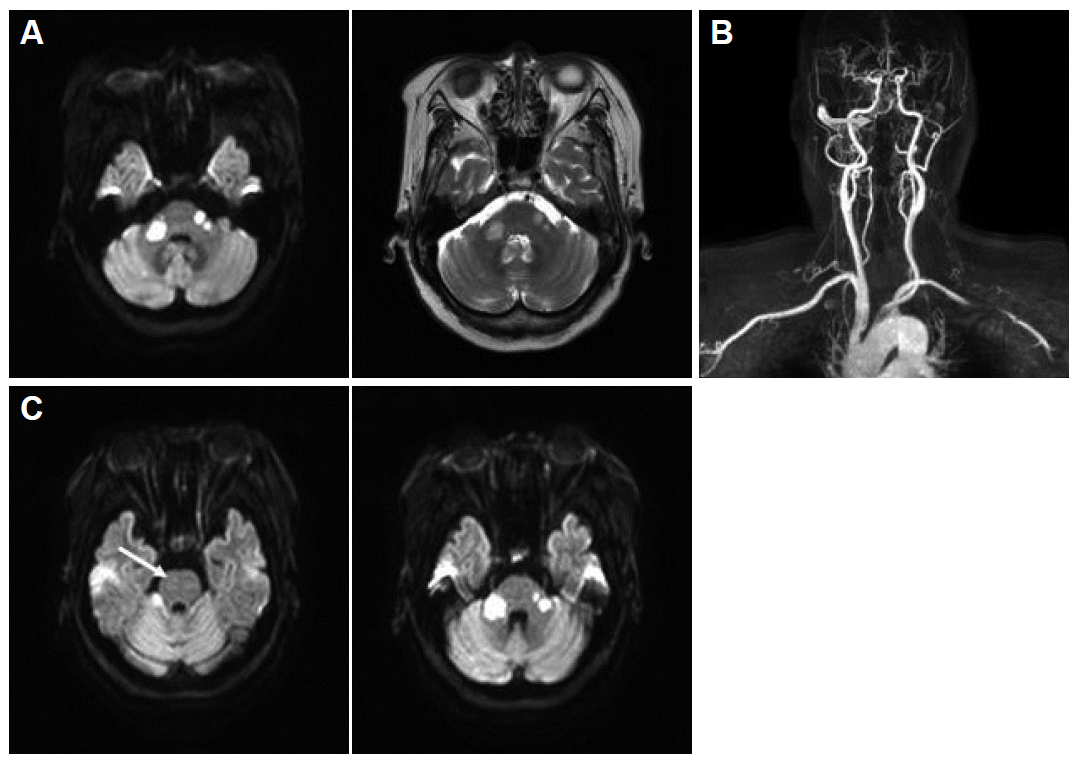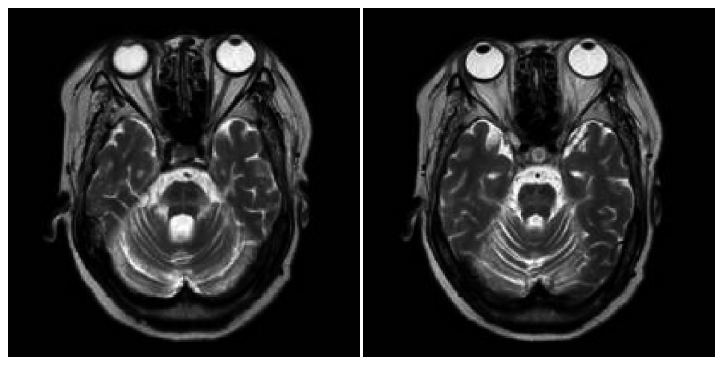Hot Cross Bun Sign Following Bilateral Pontine Infarction: A Case Report
Article information
Abstract
The hot cross bun sign is characterized by cruciform T2 signal hyperintensity in the pons and has been reported to be a specific but not pathognomic for multiple system atrophy. It reflects degeneration of pontine neurons and transverse pontocerebellar fibers, regardless of the underlying pathogenic process. Here, we report a case of hot cross bun sign following bilateral pontine infarction due to Wallerian degeneration of the pontocerebellar fibers.
The hot cross bun sign is seen on axial T2-weighted image (T2-WI) of the brain as a cruciform hyperintensity in the pons.1 It is seen in patients with multiple system atrophy-cerebellar type (MSA-c). Although the hot cross bun appearance on magnetic resonance image (MRI) can provide helpful evidence to support the clinical diagnosis of MSA-c, it may be observed in other disorders, such as reported in a patient with parkinsonism and cruciform pontine hyperintensity secondary to vasculitis.2 Here, we report a case of bilateral pontine infarction followed by hot cross bun sign on MRI without autonomic dysfunction.
Case
A 71-year-old female patient with history of hypertension and noninsulin dependent diabetes mellitus was admitted to our hospital due to sudden onset of vertigo and ataxia. At admission, blood pressure was 146/98 mm Hg, and heart rate was 97 beats/min and regular. On neurologic examination, she was alert and displayed well oriented mental function. Cranial nerve examination was normal with full extraocular movement, however, dysarthria was noticed. Motor and sensory evaluation was without any abnormality. Cerebellar function test showed gait ataxia severe enough to require support while standing. Deep tendon reflexes were hypo-active on bilateral biceps and knee jerks. Babinski’s sign was absent. Laboratory studies including C-reactive protein were unremarkable except for elevated total cholesterol (281 mg/dL) and low density lipoprotein-cholesterol (171 mg/dL). Hb A1C was 7.8% on glimepiride medication. Electrocardiography was normal. Diffusion-weighted imaging and T2-WI revealed acute infarctions in bilateral pons and right cerebellum (Figure 1A). MR angiography showed severe occlusion of bilateral vertebral arteries at V4 segment (Figure 1B) without any evidence of vertebral artery dissection. She received oral aspirin (300 mg/day). Three days later, she developed left lateral gaze limitation and horizontal diplopia. Diffusion scan was performed again, which revealed a new small acute infarction in the right paramedian pons without changes of known infarct lesions in bilateral pons covering middle cerebella peduncles (MCPs) (Figure 1C). Intravenous heparin was injected for 5 days. The dysarthria and diplopia were improved gradually, but ataxic gait persisted. She was transfered to a rehabilitation hospital. One year later, her neurologic examination was significant for action tremor of both hands. She could walk only with cane, but dizziness was not severe. Three-position blood pressure did not show any definite change, and autonomic function test was normal. Follow-up T2-WI demonstrated olivopontocerebellar atrophy and cruciform pontine hypertensity, called a hot cross bun sign (Figure 2).

A: Diffusion-weighted and T2-weighted MRI showed high signal intensities in bilateral pons and right cerebellum. B: Magnetic resonance angiography demonstrated nonvisualization of both vertebral artery, which were suggestive of severe occlusion at bilateral vertebral arteries V4 proximal portion (arrow). C: The second diffusion scan showed new tiny infarction in right paramedial pons (arrow) and no change of known infarct lesions in bilateral pons covering middle cerebellar peduncles.
Discussion
We described a case of bilateral pontine infarction with hot cross bun sign. Acute bilateral occlusion of vertebral arteries might have led to ischemia of the bilateral pons covering MCPs, right cerebellum, and paramedian pons.
Bilateral involvement of the MCPs is a relatively rare infarction, and has been reported in a few patients with complete unilateral or bilateral occlusion or stenosis of vertebral arteries.3,4 The MCPs constitute a massive bundle of fibers connecting the basal portion of the pons with the cerebellum. Through the transverse pontine fibers and MCPs, the pontine nuclei project almost exclusively to the contralateral cerebellum, which constitute the pontocerebellar tract.5 Wallerian degeneration of these pontocerebellar tracts causes pontocerebellar atrophy.
The hot cross bun sign is due to selective loss of myelinated transverse pontocerebellar fibers and neurons in the pontine raphe with preservation of the pontine tegmentum and corticospinal tracts.6 This sign reflects degeneration of pontine neurons and transverse pontocerebellar fibers. Although it is characteristic of neurodegenerative disorders,7,8 it is seen irrespective of the underlying pathogenetic process.7 In addition to neurodegenerative disease, several other pathologic conditions such as pontine vascular lesions affecting the MCPs can cause symmetrical bilateral hyperintensities on T2-WI of the pontocerebellar fibers.
Our case demonstrated cruciform pontine hyperintensities on T2-WI and atrophy of pons and cerebellum, which were observed 1 year after bilateral pontine infarction. The hot cross bun sign can be attributed to Wallerian degeneration of the pontocerebellar tract after pontine infarction without involvement of MSA-c.
